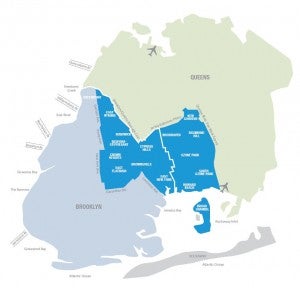How One Utility Is Changing the Clean Energy Business in Brooklyn and Queens
 By Gabriela B. Zayas del Rio, Tom Graff Diversity Fellow, Clean Energy
By Gabriela B. Zayas del Rio, Tom Graff Diversity Fellow, Clean Energy
The system for supplying electricity in the U.S. was premised on the assumption that utilities would make evermore electricity to sell to customers. But, the global need to reduce carbon emissions from traditional power generation, along with the emergence of distributed energy resources – small, grid-connected devices, like rooftop solar and energy storage – have disrupted demand for electricity produced from traditional power plants.
In May, the New York State Public Service Commission introduced a new way to pay the state’s utilities, one where utilities are compensated not just based on how much electricity they produce, but also for producing environmental benefits aligned with the public good. This approach aligns with Reforming the Energy Vision (REV) – New York’s official plan to make its electric grid cleaner, more efficient, and affordable – and comes at a time of unparalleled population growth in New York.

Keeping pace with the changing grid and REV, New York utility Consolidated Edison (ConEd) is delaying investments in new substations and transmissions lines. Instead, the utility is opting for innovative alternatives to meet increasing energy demands in dense urban areas, like Brooklyn and Queens, which led New York’s population growth over the last year. ConEd’s Brooklyn-Queens Demand Management Program, recently rebranded as the “Neighborhood Program,” uses energy efficiency and demand response programs, which pay people to reduce energy use during periods of peak demand. The Neighborhood Program will generate 52 megawatts of electricity, of which 41 megawatts will come from participants’ efficiency and conservation efforts and distributed power sources.
A local model with scalable potential
In this year’s first quarterly report, ConEd announced it had successfully completed and surpassed its goal of generating 9 megawatts (22 percent) of electricity at the peak hour from customer-side energy efficiency measures, before its May 31 target completion date. The company contracted and installed energy efficiency systems by expanding two major programs, the Small Business Direct Install and the Multi-Family Energy Efficiency, as well as conducting virtual building audits free of charge. Both programs are part of the Energy Efficiency Portfolio Standard (EEPS), a state program to reduce electricity use by 15 percent of forecast levels by 2015.
Through Small Business Direct Install, more than 4,300 small businesses have installed, or agreed to install, efficiency measures. As a result, these small businesses have collectively reduced their electricity demand by 6.51 megawatts at peak hours (over 70 percent of the already achieved 9 megawatts) and cut their energy bills by $3,200 a year. More than 1,000 buildings have participated in, or agreed to participate in, the Multi-Family Energy Efficiency program, which is expected to reduce annual energy consumption by more than 15 million kilowatt hours – enough to power over 1,500 homes for a whole year.
[Tweet “How One Utility Is Changing the Clean Energy Business in Brooklyn and Queens”]
It’s a win-win situation: reduced energy demand and minimized environmental impact without harming businesses. What’s more, ConEd has achieved about 22 percent of its customer-side solutions, demonstrating that energy efficiency upgrades are worth investing in, especially when they save money for utilities and people. As it continues to advance customer-side solutions in an area with a population of over 300,000 New Yorkers and more than 29,000 public housing apartments, the Neighborhood Program will have to work with public entities and communities to help achieve sustainable reductions in energy demand and costs.
Community partnerships
With a goal of reducing greenhouse gas emissions 40 percent from 1990 levels by 2030, one tenet of REV is giving low-income customers the opportunity to invest in clean energy and reduce energy costs. ConEd has already partnered with the New York City Housing Authority to identify energy saving opportunities. For example, the Multi-Family Energy Efficiency program has helped with the installation of high efficiency fluorescent lighting and more efficient air conditioning units in public housing facilities.
…there is interest within communities impacted by this program to collaborate with the utility to reduce energy use and support local jobs to make the program successful in the long run
But, ConEd’s community engagement can benefit from even more attention, especially because residential properties (one to four-unit family buildings) make up 57 percent of customer accounts and nearly 30 percent of total peak demand in the Neighborhood Program area. As a recent meeting in August between ConEd and community leaders revealed, there is interest within communities impacted by this program to collaborate with the utility to reduce energy use and support local jobs to make the program successful in the long run, and last beyond 2026, the year when ConEd is set to build a new substation plant.
Looking ahead
We have the opportunity to reduce energy use, save money, and proactively break with the marginalization and isolation of low-income customers in the energy sector. This might be the perfect time to start over, giving all New Yorkers an equal opportunity to be part of the clean energy revolution. As Mark Winston Griffith, executive director at Brooklyn Movement Center, a leading organization representing communities impacted by the program, expressed, these communities are championing a third win: economic development and job creation. ConEd has an opportunity to create a clean energy economy for all. Environmental Defense Fund will continue to advocate for more community engagement as we fully materialize the future of REV.











